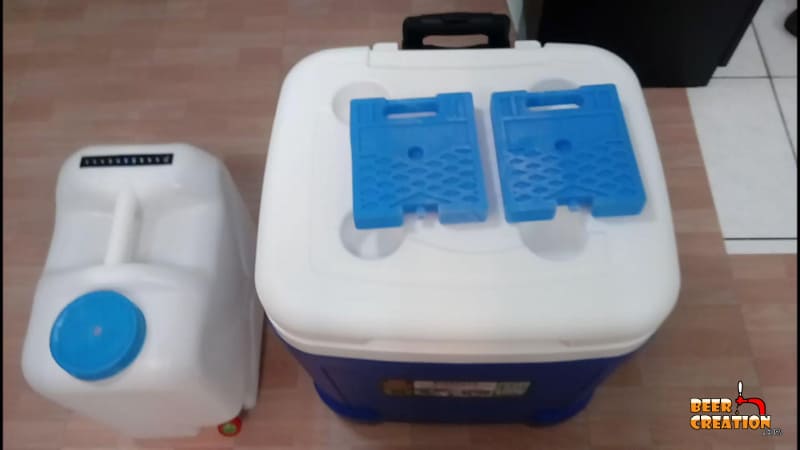After hanging out with a friend who runs his own local craft brewery, we got to talking about my latest beer creation. He had some bad news, and it was all to do with my lack of a fermentation chamber.
As Tom is something of an expert in making beer, with over 10 years of experience in the professional field, he’s a great source of advice for me.
He said that if I could control the process of fermentation a little better I could rapidly improve the quality of my beer. The culprit was simply the sudden changes in the spring weather while I had been fermenting the latest batch.
So does that mean that every homebrewer should run off and source themselves a fermentation chamber?
Controlling the temperature of your fermenting beer is extremely important. If you can keep the yeast within a certain temperature range it’ll contribute to a better-finished beer. A fermentation chamber is a very effective way of doing this in both hot & cold climates and most brewers will benefit.
The thing is though, there is a lot more to consider than just having or not having a fermentation chamber. So, because I’ve just done some research on this myself, I thought I’d share it here for everyone else.
What is a fermentation chamber?

It sounds fancier than it really is, but basically, a fermentation chamber is an enclosed box that helps you maintain the internal temperature at optimum levels for fermentation.
This can be done in lots of different ways, some of them are more high-tech than others. The approach you take really depends on how much time, space, and money you have to dedicate to this project.
In the early days, I had fairly good results with a large beer cooler and several ice packs to keep the temperature way below that of the outside summer heat. However, now that I’m a little bit more into the hobby and another summer is looming, I want to upgrade my fermentation chamber set up.
Why is temperature control so important?
The thing that many new homebrewers don’t realize, and I was certainly in this group when I first started, is that the fermentation process is exothermic.
So, even if the room you are brewing your beer in is at the perfect range, your beer could be up to 20°F (11°C) higher than the reading for the ambient room temperature.
Not only this, but the change in temperature can happen very rapidly when the yeast starts actively fermenting the beer. My mate Tom who brews with professional brewing equipment say that even he can be taken unawares by sudden changes which can happen overnight when he’s not around.
So, this is why a dedicated fermentation chamber is a must whenever you can get your hands on one.
How can it improve your beer?
According to my friend, the issue with the beer that we’d been tasting was the slight presence of phenols, an off-flavor which is usually something you don’t want. He attributed it to ‘stressed yeast’, basically my fermentation temperature wasn’t constant.
I agreed with him because that particular beer had been fermented out of the light but not under any particular temperature control because of the season.
Flavor
So, as in my case, the major benefit of maintaining the correct fermentation temperature range is that you won’t get off-flavors from a change in the yeast’s metabolism.
Yeast viability
In addition to the by-products from your yeast attenuation, pitching and the fermenting around the right temperature for that yeast strain will ensure healthy growth and a better-balanced beer in several ways.
UV light
In the midst of this conversation of temperature, let’s not forget the other benefit of fermenting in a enclosed fermentation chamber, the absence of light.
UV light is going to not only contribute to the higher temperature in your fermenter but it can also lead to off-flavors in your beer, especially with hoppy beers which will taste skunky.
New to homebrewing? Please feel free to read my ultimate guide to brewing beer at home and where to start.
What happens if beer is fermented at too high or low of a temperature?
Let’s not forget the fact that yeast is a living organism and as with any other living thing it’s affected by it’s environment.
When too cold yeast will become less efficient in turning fermentable sugars into ethanol and may even become dormant and fall out of suspension, becoming fairly useless unless the temperature rises.
When too hot, yeast will actually go through a stage of over-production where they gorge themselves on the nutrients in the beer. Although this may sound like exactly what you want for a fast fermenting beer, they will also produce several off-flavors from esters, to diacetyl to phenols. You’ll also get fusel alcohols which are far less palatable than the usual ethanol we want in beer.
So, it’s important to get your process control, as my friend would say, under control if you want to brew any beer of your choice at any time of year.
When you should consider having a fermentation chamber
As I said before, I made do with a very basic fermentation chamber for a long time and that was fine while I was learning the ropes. Now, however, I’m getting to the stage in my homebrewing career where I want to develop my craft a little more. Also, I’m sharing my beer with a wider audience and I don’t want to give homebrewing a bad name!
So, just from personal experience, I would say don’t worry about shelling out a lot of money on a ‘proper’ fermentation chamber for your first one to five batches. After about this stage you’ll know if you want to delve deeper into the hobby or not.
I’m going to wager that you will want to hone your skills a little more, so let’s talk about your options.
DIY or buy a fermentation chamber?
You can definitely buy a ready-made unit which will help you keep your fermenting beer at the right temperature, but I think this is rarely necessary. So let’s first talk about some DIY options you can try, some of which I’ve also used myself in the past.
DIY hacks to cool your fermenter
Just because it’s what I’m facing at the moment, let’s start with the problem of cooling your fermenting beer effectively.
Beer cooler method
What you’ll need:
- a large enough beer cooler
- several flat ice packs
- blow off tube
- a (digital) thermometer
Method:
The main issue you’ll have here is finding a cooler which is big enough for your fermenting bucket or your carboy (see my article here is you’re wondering which one to use). I actually was using a food-grade plastic water container as it was much thinner than my regular carboy.
Once you have racked your wort, place it in the cooler and, assuming you have chilled it to the ideal pitching temperature, go ahead and pitch your wort.
Insert a blow-off tube into your fermenter and place the other end in a bottle of sanitizing. Place several ice packs around the fermenter and put your thermometer on top of the fermenter. If you have a stick-on thermometer or even a probe, I’d recommend using them in addition to a digital thermometer.
Monitor the internal temperature of the cooler and replace the ice packs as necessary. For me it was about once a day during the height of summer.
How effective is it?
I’d give this a medium level of effectiveness because you have to be present to monitor the temperature change yourself.
Water trough or swamp method
What you’ll need:
- a large container
- a large piece of cloth
- ice packs
- a thermometer
- a fan
Method:
This isn’t a method that I’ve tried but I have heard other brewers talk about it and even John Palmer talks about it in his book How to Brew. As far as I understand it, it works on the principle of evaporation and the heat exchange properties of water.
Place your fermenter in your container and fill it with water and place the ice packs in it. The more water the better and the more of the fermenter is covered, the more effective it seems to be.
If you don’t have a big enough container to safely immerse 50% to two-thirds of your fermenter (just make sure it doesn’t tip over!) then you can use the cloth to wrap around the fermenter and keep it moist.
Monitor the temperature of the water and the fermenter by using adhesive thermometers and ones with probes, add ice packs as needed. You can also use a fan directed at the container of water to help cool down the fermenter by helping the evaporation process.
This method really works well because liquid will gain and lose heat slower than a solid, so the water keeps your beer cool during the day and warmer at night. John Palmer explains how his friend was able to keep his beer between 60-70 °F while the ambient temperature was closer to 90°F.
How effective is it?
Again, I think this is kind of a medium level of effectiveness and is best used as a stop gap if anything.
Son of Fermentation chiller
What you’ll need:
Method:
This is actually a low tech and low energy consuming option, which I’m really interested in building for myself.
The basic principle here is to insulate a box in which you place buckets of ice, a fan and your fermenter. By using a thermostat, you can regulate the temperature which is cooled by using convection and the cooling effect of the ice.
Although this may cost you the same to build as buying an old refrigerator and all the thermostat controller its main advantage is that it’s compact and uses a lot less energy than a second-hand fridge.
How effective is it?
In terms of cost, it’s definitely up there. According to what I’ve read it’s also as effective as using a fridge or freezer. I’ll have to wait to give my own results for a future post.
Chest freezer/ Upright refrigerator
What you’ll need:
- Chest freezer or upright refrigerator
- Ink bird thermostat controller or similar
Method:
I think this is the most common way for homebrewers to build a fermentation chamber and I can see why many people go down this route.
All you really need to do is to fit an ink bird (link to Amazon) unit to a conventional chest freezer or fridge and you are ready to go. As the temperature rises or falls beyond the range you’ve set on the ink bird, it will turn the freezer or fridge on or off.
The only thing to consider here is that you need the space for the freezer or refrigerator and to pay for the energy to power it. However, for most people that’s not too much of a concern.
You can also think about forgoing your wort chiller and chilling your wort directly in the fermentation chamber rather than in your brew kettle, check out my full article on whether or not you should be doing this.
How effective is it?
From my friends who have gone down this route, one of whom who sells his homebrew in his bar (legally!), I know that this is a very effective method of fermenting beer. You can also make the unit multi-functional if kegging and turn it into a keezer or kegerator.
Go high tech – Conical Fermenter

What you’ll need:
- the Grainfather Conical Bundle (see Amazon for latest prices)
Method:
Although perhaps not in everyone’s budget, if you really want to get serious the going down this route will make sure that you can produce beer in a very professional way.
The Conical fermenter in this Grainfather bundle is basically a mini version of what my friend uses in his professional brewery. It has an inbuilt cooling sleeve which will help you keep your fermentation temperature perfect every time. Definitely on my wish list.
How effective is it?
Man, just look at the thing!
DIY cold storage room
Another way that I’ve used to keep my fermenting beer cool was to crank up the air conditioner and cool the entire room down. It can work, but there is a better way. Why not turn an entire room, preferable a small one, into a cold storage area.
DIY hacks to heat up your fermenter
Most of this article has been about how to cool your fermenting beer down, but that’s mainly because I’m writing this just before the summer heat hits. Of course, if you are brewing in winter you probably have the other issue.
A fermenting chamber can work the other way too and help you to keep your beer warmer than the ambient room temperature, but here are some hacks I’ve seen which can help.
Hack #1: Insulation
Depending on where you are brewing, you can simply wrap your carboy or fermenting vessel up in a towel, thermal sleeping bag, or layers of blankets. This may be enough if you have the beer fermenting in the main living area of a house.
You can also go down the route of using electronic heating pads or brew belts (links to Amazon) which you can use to monitor the temperature and turn on or off as needed.
Hack #2: Heat lamp
If you have already built yourself a fermenting chamber from an old fridge or freezer, then you can use the inbuilt insulation to your advantage. By fitting a low-powered heat lamp (link to Amazon), like used for heating a lizard aquarium, you can get the right temperature you need, without turning the freezer on of course!
How much space do you need for a fermentation chamber?
The space you’ll need really depends on the method you use and the footprint of your fermenting vessel.
Fermenting vessel | Floor area |
|---|---|
729 inches2 | |
597.6 inches2 | |
464 inches2 | |
Frigidaire (12.8-cu ftà | 1460.25 inches2 |
225 inches2 |
Reasons not to have a fermentation chamber
The biggest reasons not to invest in some sort of fermentation chamber are going to be subjective but ultimately come down to cost and space.
If you fall into this group, then perhaps you can just approach brewing beer in a more seasonal way. By this I mean, brew beers in the summer which takes advantage of yeast which tolerates higher temperatures, and brew your lagers and beers in the winter with yeast which can work at colder temperatures.





